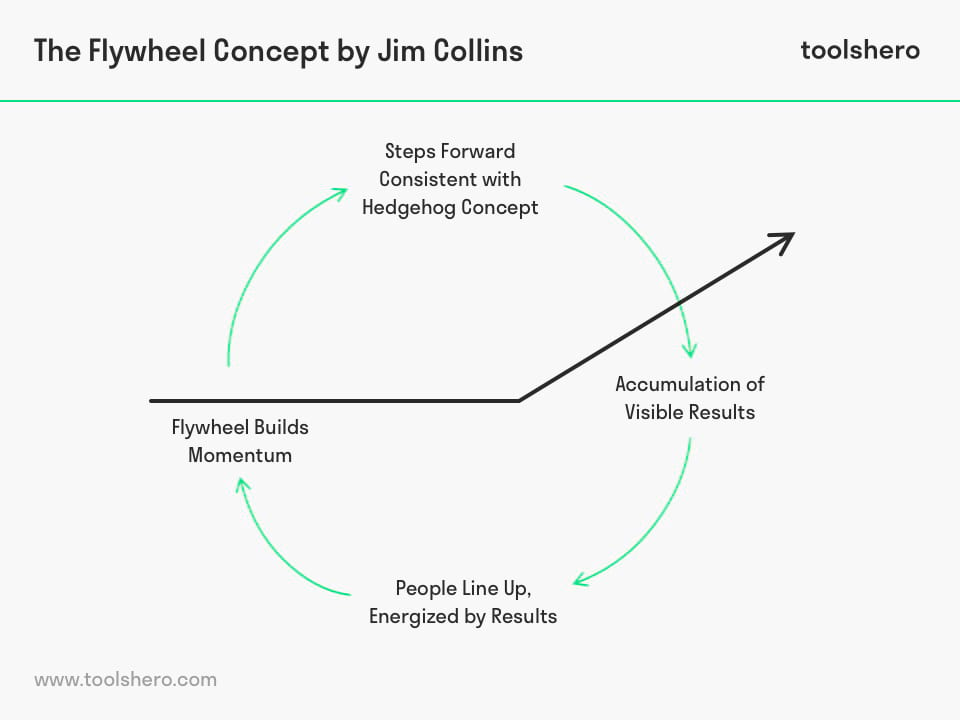Flywheel Concept by Jim Collins

Flywheel Concept: this article describes the Flywheel Concept, created by Jim Collins, in a practical way. Next to what it is, this article also highlights the Doom Loop effect and the signs that are involved. After reading you will understand the definition and basics of this strategy tool. Enjoy reading!
What is the Flywheel Concept?
A flywheel is a mechanical device specifically designed to store rotational energy efficiently.
A flywheel resist changes in rotational speed by their moment of inertia. The amount of energy stored in a flywheel is proportional to the square of its rotational speed and its mass. The way to change a flywheel’s stored energy without changing its mass is by increasing or decreasing its rotational speed.
The Flywheel Concept is a term that was first used by Jim Collins in his book ‘Good to Great’, to address companies that can compare their business strategy with a massive flywheel.
The general idea behind this concept is that it usually costs a lot of effort to get an enormous flywheel into motion. Still, when it found its momentum, the counter joints at the outside of the flywheel create more force and power. As a result, the flywheel can move faster and more efficiently with less effort.
The Flywheel Concept visualizes this theory into businesses. According to Jim Collins, the tremendous power of great companies is derived from continuous improvement and the delivery of results.
Therefore, the Flywheel Concept shows that businesses put a lot of effort into accomplishing incremental improvements. Still, when all these improvements have been accumulated, people in the organization feel this force and adapt to it, which results in realizing results faster and of with lesser effort.

Figure 1 – the Flywheel Concept (Collins)
According to the Flywheel Concept, small, medium, and large size companies invest a lot of hours into an organization for it to become successful. Many times, the results of the spent time are not noticeable, or even more specifically, it is not seen directly in the organizational outcomes.
Usually, these individuals or teams continue to invest time in the business until a breakthrough moment arises. This is the time the company’s results are more visible in terms of revenues. As a consequence, the organizational results will keep on improving quicker and quicker because of the tremendous force.
Jim Collins additionally argues that a flywheel effect will always occur to all great and successful companies because none of the great companies can ever implement significant transformations without making smaller steps. A company can have a great goal, but the only way to reach that goal is by creating and making sure of achieving small objectives.
An essential element of the Flywheel Concept is that businesses must look from the inside to the outside. The idea of Jim Collins is to compare a company with an egg in which a chick is developing. Imagine how this egg would look like to the general public.
Everyone might think it is just an egg until the moment the chick cracks the eggshell to live in the outside world. From the moment the chick cracks the eggshell, it draws public attention because of the breakthrough moment.
However, while the general public did their daily activities, the chick was unnoticed going through various development processes. This is also what happens to many organizations. Frequently, these businesses make developmental steps that are unnoticed to the outside world until they reach a breakthrough moment.
Strategic Business Planning: Formulate Effective Strategies
The Doom Loop effect vs the Flywheel Concept
The doom loop effect is the opposite of the flywheel effect. It is another concept created by Jim Collins, which is additionally described in his book ‘Good to Great’. In this book, Jim Collins associates the doom loop effect with comparison companies instead of great companies.
The doom loop effect is on the contrary to the Flywheel Concept concerned with continually making new efforts or implementing new ideas to motivate people in the organization.
For example, a CEO might decide to launch a new product and motivate the team to put in all efforts to make the product or other plan a success. However, from all-new incentives, only a small portion will become successful.
In case if these incentives show development, they do not make a drastic change to the organizational strategies. These incentives could improve business performance but will not make the breakthrough.
The idea about the doom loop effect is that people seek for the breakthrough moment by creating and implementing new ideas. This motivates the team, but companies also receive quick feedback, such as a business outcome that do not meet expectations.
It is expected that only one or a few new initiatives would create a breakthrough moment. However, like the explanation about the egg and the chick in the previous section, it is impossible to skip developmental steps to become successful.
The doom loop effect shows that these types of leaders implement various programs and hope to reach that breakthrough moment. The programs receive reaction without understanding, and as a consequence, a new direction or plan is many times chosen. And again, with the hope to reach the breakthrough moment.
However, there is no accumulated momentum as in the Flywheel Concept where all the build-up forces work together to gain power, and thus also reach significant improvement.
As a result, disappointing results arise again and lead to the first step, which is creating or implementing new ideas with the hope it will make a breakthrough.
Signs that show if your company is on the Flywheel or in the Doom Loop
Companies that follow a pattern of buildup in the hope it will lead to breakthrough are the ones that follow the flywheel strategy. These types of companies reach a breakthrough by taking many incremental steps, one by one. It is expected that these organizations do not think in terms of future speculations but focus more on smaller results that together form a transformational process.
Companies that experience the force of the Flywheel Concept deal with facts and try to solve conflict as soon as possible, and if possible, determine the necessary steps that must be taken to build the momentum of the flywheel.
Another characteristic of companies on the flywheel is that these businesses utilize the Hedgehog concept. These firms comprise an engaged and disciplined workforce.
More importantly, people who work in these types of organizations spend little time on motivating people because they are already engaged and feel the momentum of the flywheel, which is the significant power that drives a business.
On the contrary, companies that are in the doom loop attempt to skip the buildup and implement large and broad initiatives. These companies are searching for a miracle which is probably not going to happen.
These businesses are inconsistent with implemented initiatives and frequently try to generate new ideas when one turns out not to be the miracle. In addition, these organizations jump right into implementation without rational and disciplined thought and spend a lot of time on motivating employees.
In conclusion about the Flywheel Concept
The bottom line of the Flywheel Concept is that great and successful companies always go through various developmental stages. A breakthrough is still the result of an accumulation of multiple improvements created by the force of the people.
Regardless of the input of particular individuals, it is the combined energy that creates motion in the Flywheel Concept. The strength and consistency of all employees are needed to realize breakthroughs and create a great and successful organization.
Once an organization has reached a breakthrough, and thus, the momentum of rotation of the flywheel, the wheel only spins harder, and a result, business results become visible more obviously.
Now it’s your turn
What do you think? Are you familiar with the explanation of the Flywheel Concept? Do you think your company is in the flywheel or in the doom loop, or have your company experienced both? How can the explanation of the Flywheel Concept help your business? Do you have comments or any additions?
Share your experience and knowledge in the comments box below.
More information
- Caulkins, D. D. (2008). Re-theorizing Jim Collins’s culture of discipline in Good to Great. Innovation: The European journal of social science research, 21(3), 217-232.
- Collins, J. (2006). Level 5 leadership: The triumph of humility and fierce resolve. Managing Innovation and Change, 234.
- Collins, J. (2006). Where are you on your journey from Good to Great. Good to Great Diagnostic Tool. Version, 1, 1-22.
- Collins, J. (2009). Good to Great-(Why Some Companies Make the Leap and others Don’t).
- Collins, J. (2019). Turning the Flywheel: A Monograph to Accompany Good to Great. Random House.
- Finnie, W. C., & Abraham, S. C. (2002). Getting from good to great: a conversation with Jim Collins. Strategy & Leadership, 30(5), 10-14.
- Lee, D. P. W., & Yacong, L. (2015). Applicability of Jim Collins’s Good to Great Framework for Enactus China. Journal of Asia Entrepreneurship and Sustainability, 11(5), 53.
How to cite this article:
Zeeman, A. (2019). Flywheel Concept (Collins). Retrieved [insert date] from Toolshero: https://www.toolshero.com/strategy/flywheel-concept/
Original publication date: 01/12/2019 | Last update: 12/22/2023
Add a link to this page on your website:
<a href=”https://www.toolshero.com/strategy/flywheel-concept/”>Toolshero: Flywheel Concept (Collins)</a>












